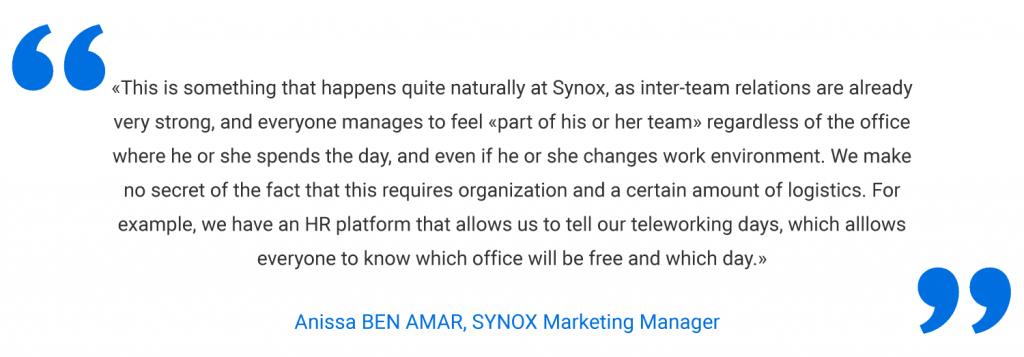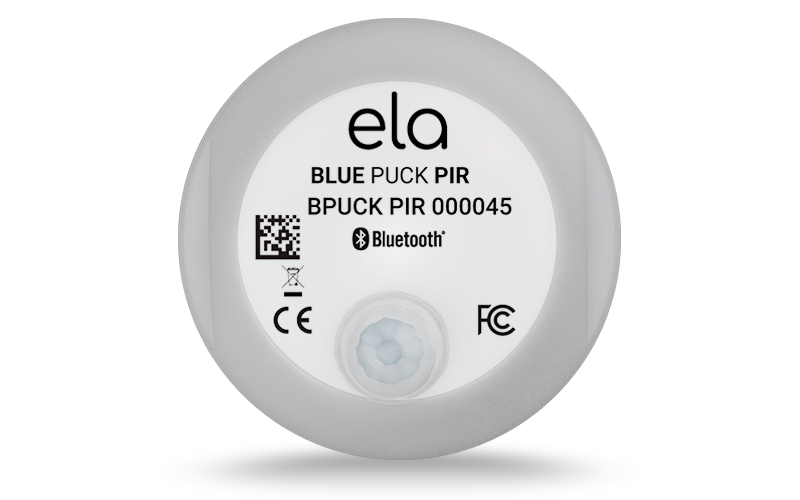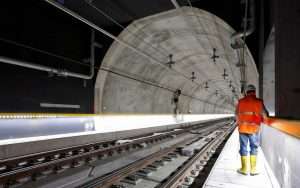6 Steps to transform your traditional workplace into a Flex Office
Reading time
Level

It is not a secret that teleworking is now becoming an increasinly popular new way of working. However, despite its popularity, a majority of employer want to keep physical premises and one of the main reason for that is that they find conviviality in their workplace. This is why more and more companies are ready to adapt their workplace management through a occupancy monitoring system, or what is is commonly called “Flex office“. Technology has now evolved to the point were it is now possible to give employees a dynamic and flexible office space. But how exactly will it optimise the workspaces? And how can you do it ?
What is a Flex Office?
Flex office is a new way of organizing work by monitoring the rooms’ occupancy. It is also called about desk sharing or shared office. It is a question of leaving the limits of the personal desk/office. The objective is to offer different workspaces, according to one’s needs: coworking, confidentility bubbles, conviviality spaces, modular meeting rooms or even sports rooms. These convivial spaces meet the new expection of employees while facilitating exchange and collaborative work.
The challenges of the flex office are therefore not limited to the simple optimization of space. First of all, it i a strong desire to rethink our relationship with work. Because the company is much more than a place where we come to work. Thanks to new technologies, it is now possible to imagine new work organizations where the well-being of emplouees and their legitimate demand for flexibiliy can find an appropriate response.
What are the benefits of a Flex Office ?
The flex office is a freer system than the traditional one, more… well, flexible. It offers many advantages for the company and its employees.
Fostering internal communication and team spirit
A company is a group of people working together. However, we see in traditional organizations that members of different departments do not mix easily. It’s a bit like being in the middle of the room.
By physically decompartmentalizing the departments, we naturally encourage exchanges outside the simple professional framework. The result is improved internal communication and better collaboration. The entire company becomes one team.
Improved well-being at work and employee motivation
The motivation of employees is very often linked to a good working atmosphere. The organization of convivial moments within the company also contributes to the feeling of belonging and attachment of the employees to their company. This is not possible with 100% teleworking.
However, employees who were able to telework during the pandemic are not keen on a return to 100% face-to-face work. According to an OpinionWay study, “60% of French workers say that if their company encouraged them to organize their own time, choosing their own hours would make them appreciate their company more”.
Adaptation to the flexibility needs of employees for a better balance between professional and personal life
What sociologists call Millennials, or Generation Y, will make up about 75% of the workforce by 2025. This generation is known for placing a real emphasis on their well-being and personal fulfillment. It is also a particularly difficult profile to recruit. Even more difficult to retain.
For human resources, the flex office can therefore become a competitive advantage over more traditional companies. Because this organization meets the needs of flexibility and autonomy of employees in the management of their working day. Finding a balance between professional and personal life is finally an important issue for everyone.
Reducing its environmental impact for strong corporate values
Until very recently, having a job meant going to work. That is to say, having to be present in the company’s premises at specific times every day of the week. The negative effects of this are the traffic jams of the famous rush hours, the degraded air quality due to car pollution, which has become a real public health problem, and finally an unbearable waste of time in transportation.
Today, corporate social responsibility (CSR), i.e., social and environmental commitments, also represents a strong lever for employee loyalty. Far from the metro/work/sleep triptych, employees want to give meaning to their work. And working for a company that is committed to strong values makes sense for 85% of French workers (source: OpinionWay).
Reduction of fixed costs through workspace optimization
The reduction of fixed costs is indeed another positive point of the flex office. Energy costs for heating, for example, will undoubtedly rise sharply in the coming years. This is especially true for older buildings.
With real time occupancy monitoring, you avoid unnecessary expenses. On the contrary, you even manage your workspaces better. The company can also rent or sublet part of its unoccupied offices and offer a coworking service for example.
Finally, the vast majority of employees want more flexibility and autonomy in their work organization. The flex office therefore makes it possible to adapt to the expectations of employees and the need for efficiency in companies. Provided that certain steps are respected in its implementation.
SYNOX company testifies
As part of its development, the Montpellier-based company SYNOX aims to double its workforce by 2023. It is thus imperative for the company to find a solution allowing each collaborator to spend time in the office (and not only in teleworking). The teams have chosen the flex office which allows them to reinforce the human links which are at the heart of their quality of life at work policy.
Find out how this strategy has been received by the teams.

How to organize the Flex Office? 6 steps to follow
The will to organize the flex office is based on a real company project in which everyone must be able to find their place. This is why we invite you to follow these 6 steps.
1. Involve employees
Employee buy-in is essential to the success of this transition to the new organization. This work environment is also based on a form of participative management. This must allow for regular feedback where everyone feels considered and therefore more involved.
2. Communicate with transparency and education
Employees, like consumers, expect more and more transparency from companies. And like any organizational change, the first perceived risk is a loss of reference points. The objective of communicating with pedagogy is therefore to accompany the employees. The interest is to limit the possible stress or the natural brakes to change.
3. Multiply the collaborative spaces
Collaborative spaces are a way to evolve towards more collective work. To facilitate exchanges and get away from the physical barriers represented by individual offices, it is essential to multiply shared spaces. The goal is naturally to propose new types of spaces that favor project mode.
4. Best estimate of the room occupancy rate
The occupancy rate is the ratio between the number of occupied workstations and the total number of existing workstations. Since there is no longer a fixed office in a flex office, we can estimate that this type of organization amounts to offering about 0.8 workstations per employee.
5. Consider doing a test phase
There will always be gaps between theory and practice. Thus, a test phase will allow to highlight the points to be improved. Indeed, the technical aspect of the flex office is a crucial point to take into account. This is why 52% of companies wishing to adopt the flex office want to benefit from support (source JLL).
To find out how ELA Innovation can help you with your project, contact one of our consultants.
6. Use the right digital tools
Better use of digital tools would have a positive impact on the company’s image for 42% of employees. Using the right tools to set up a flex office is essential to ensure that everyone will find their place. The advantage for the employee is to easily find an available office and a good computer connection.
It’s when technology knows how to make itself invisible that it is truly effective. And that’s exactly what IoT is all about.
Facilitate the management of your resources with IoT
The IoT, or Internet of Things, can be defined as a set of physical objects that can connect to the Internet. This represents a fast-growing market: forecasts estimate that there will be more than 40 billion connected objects by 2027. The interest of the IoT is indeed to facilitate the management of its resources.

Découvrez notre capteur de présence infrarouge
pour la mesure du taux d’occupation des bureaux
Use of infrared presence sensor, working in Bluetooth.
100% anonymous and autonomous, infrared presence sensors are perfect for flex office applications. The high sensitivity of a sensor such as the Blue Puck Pir detects the slightest movement. This makes it easy to determine whether or not a room, office or cubicle is occupied.
Real-time visualization of free rooms
Each high-quality, low-power Bluetooth sensor is then connected to an IoT platform, using what is known as a gateway. It is this connection that will transmit objective and reliable occupancy data to the system. In other words, to simply obtain a real-time visualization of free space.
Simplification of remote workspace reservations
On their side, users just have to connect to the application or to the web portal to find the available space adapted to their needs: free office, quiet room, creative room or meeting room. The system allows users to book remotely and even to free up spaces that have been reserved but not yet used.
Quick and non-intrusive set up
The set up of Bluetooth sensors is indeed very fast and non intrusive. Since it doesn’t require any wiring, these completly anonymous presence sensors can be fixed on any surface (under a desk, on the ceiling, on a wall or a door). For example, 351 Bluetooths Low Energy presence sensors were installed on 1001 Vies Habitat’s two sites of 2 800m² and 600m² in only 3 days.
By using IoT, the implementation of the flex office in the company is much more easier. To guarantee the success of this project, it is therefore better to rely on the technical skills of a specialist.
Discover how ELA Innovation and its partner Z#bre helped 1001 Vies Habitat to optimize its workspaces.
Mistakes to avoid when switching to Flex Office
It can be quite tricky to implement a Flex office management, so we made a list of all the mistake to avoid when switching to Flex Office :
Don’t go too fast
Just like any big changes, it is better to go step by step. The success behind a good Flex office application goes through an analysis of employees’ work habits. It is also important to take time to do tests. Wanting to go too fast can cost you the whole project.
Don’t use the wrong IT equipment
A solid infrastructure must be supported by innovative and efficient technologies. The Internet of Things supports our daily lives by giving us access to practical reliable information. A good wireless connection is, of course, essential for ideal working conditions.
Do not impose the flex office upon employee
This new work organization is also a new form of management. The involvement of top management and employee support for the project are naturally among the keys to its success.
Indeed, the flex-office is a way to move towards a more collective approach, for employees who are more autonomous and more involved in the company’s life.
Last but not least, successfully transition to Flex Office!
At last, successfully transition to flex office is a change in the company’s culture. It’s a matter of rethinking our relationship with work for more flexibility, but also more conviviality for a better well-being at work. A strong argument to recruit and retain talent.
The world of work can evolve today thanks to new technologies. Being able to be supported in its transition to a flex office is a guarantee of success. This is why ELA Innovation partners with innovative solution providers such as Z#bre to meet the new challenges of companies.
Do you have any questions? Contact our experts now for personalized advice on your flex office project.






